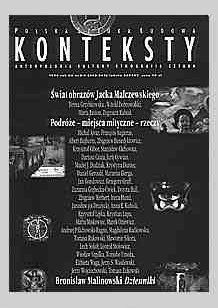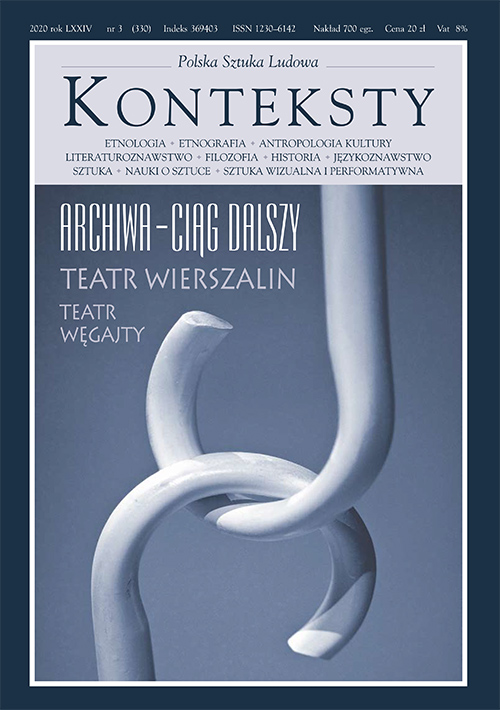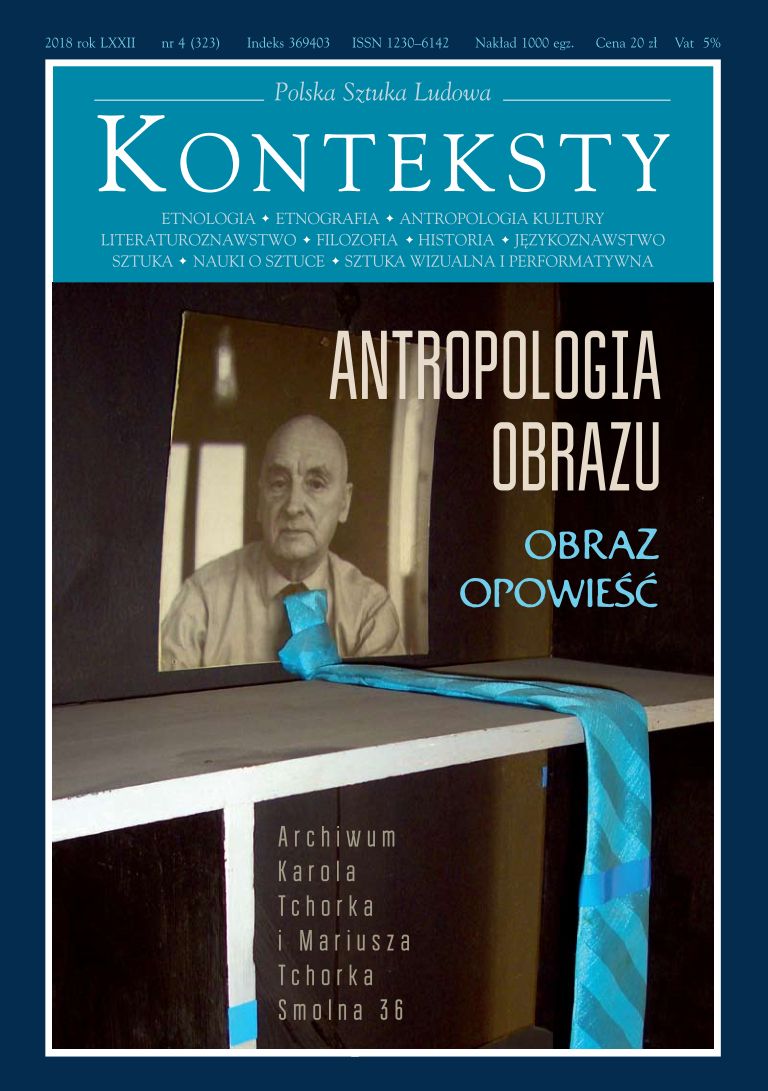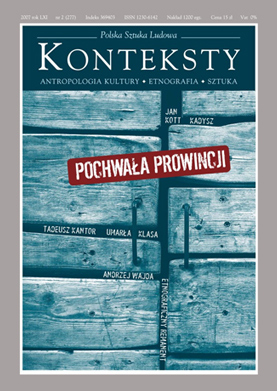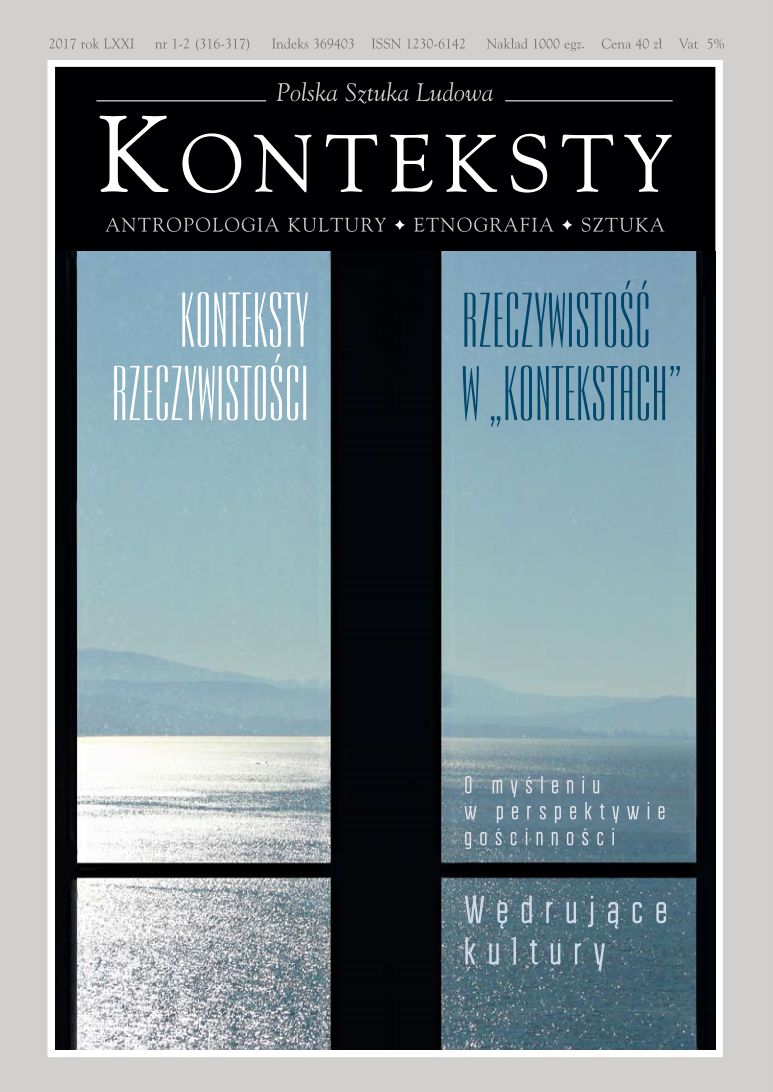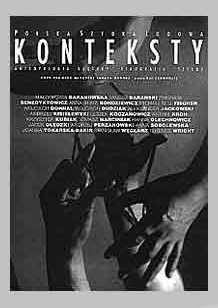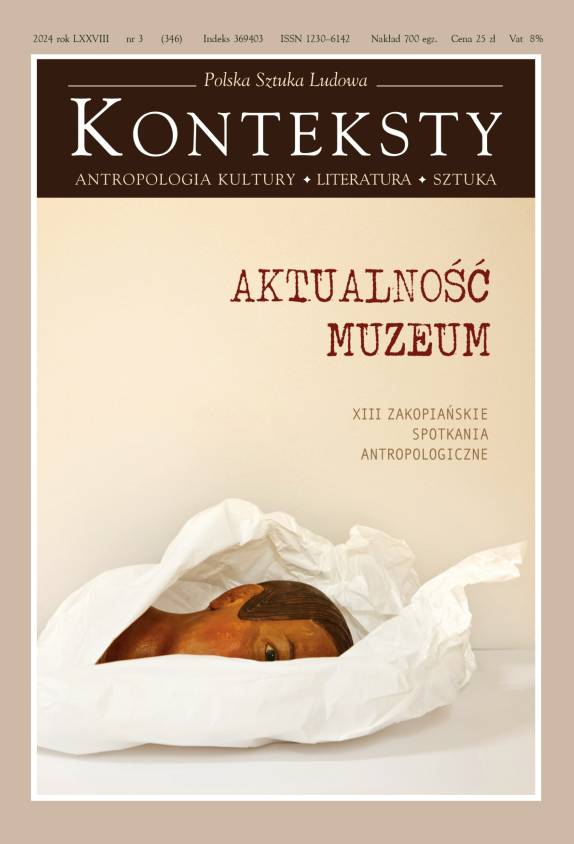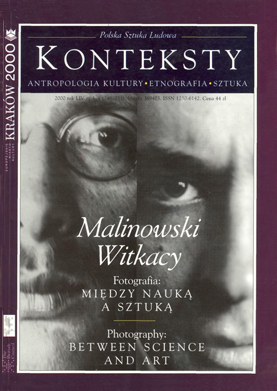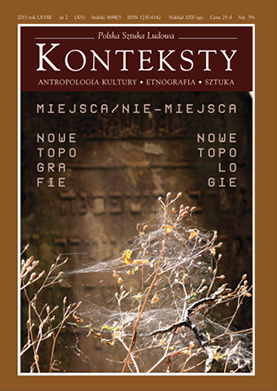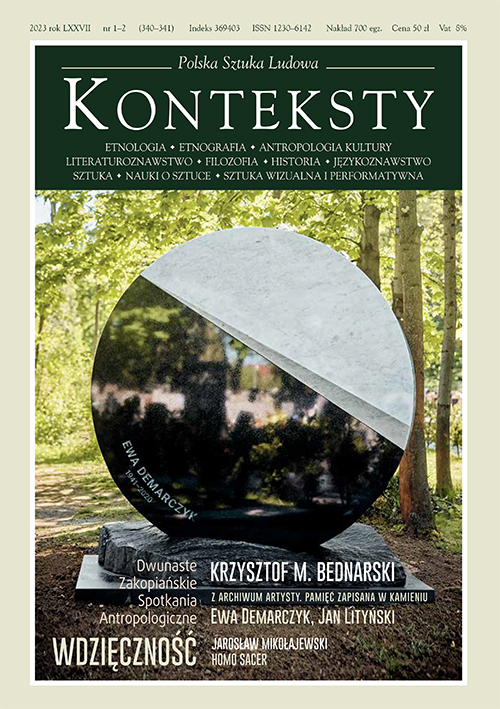Issue 2011/4 (295) - Konteksty

| Dariusz Czaja | 3 | |
| Zbigniew Benedyktowicz | 6 | |
| *** | ||
| Paweł Próchniak | Underpinning of the Night  | 9 |
The author proposes several interpretations of one of the most prominent motifs in the works of Czesław Miłosz, treated as a continuum of imagination spanning between the volume Three Winters and Last Poems. The presented sketch attempts encompassing within a single look a sequence of images and associated poetic and existential qualities conceived as analogons of experiencing the night – especially its spiritual dimension. The point of departure for further reflection is intuition, regarded by Miłosz as prominent and treating poetry as a “quest for Reality”, confronted with tension, of key importance for twentieth-century poetry; one of its extremities is the conviction that language is man’s true realm, while the other is delineated by the feeling that language, envisaged as the source of imagination, contains information about another Kingdom. | ||
| Aleksandra Janus | Particular Instances  | 15 |
An image from the book The Wonderful Adventures of Nils, which Miłosz read as a child and to which he returned in his speech given upon the occasion of receiving the Nobel Prize in Literature, constitutes a metaphor of the poet’s calling: to soar above the Earth and embrace it in a single gaze, while at the same time noticing every detail, “to see” from high up and close by, and then to describe as faithfully as possible. An irrefutable faith in the belief in the world and the pursuit of mimesis are the motor force of such poetry, accompanied by the crucial question of adequacy and reference as well as the endless battle waged by literature against that, which is revealed to us as reality. Despite the fact that it remains clumsy in contact with reality, language is the sole tool of cognition and understanding at our disposal. Time and again, we embark upon attempts at reaching reality with the aid of the word, and at efforts, made anew, to reveal the mystery of the world, even if inaccessibleness is part of the essence of all things. | ||
| Andrzej Kramarz | 19 | |
| Zofia Król | The Attentive Poet  | 23 |
The story of attention is one of the most important motifs in the return of the human spirit to the world. Czesław Miłosz, in his capacity as an attentive poet, made an inventory of fragments of reality, recorded it in a magic register of poetry, transferred it beyond the range of the passage of time, and salvaged it. Most important, however, proves to be not the process of saving fleeting moments for the sake of eternity, but opening the reader up towards a new dimension so that the question of living among people would become more captivating. | ||
| Wojciech Bałus | Catalogue of Data Evaded by the Ultimate Meaning  | 30 |
In his poem No More (1957) Czesław Miłosz evoked Two Venetian Courtesans, a painting by Vittorio Carpaccio. The work in question concerns the passage of time, but also attempts to preserve forever both fleeting impressions and experiences (epiphany). The introduction of an ekphrasis of a painting makes it possible to capture and halt the disintegration of bodies and the flight of events. Simultaneously, in accordance with the anthology of the image expounded by Hans Belting, the painting grants its medium that, which is no longer and which has lapsed. Hence works of art and poetry recall to a certain extent the post-apokatastasis state that the poet found so fascinating. They retain unusual moments, render epiphanies indelible, cleanse the world of all haphazard elements, and although they are incapable of halting all that, which occurred in the past and pause merely beauty, they nonetheless comprise an element of absolute, divine memory according to which the renascence of the entire world will take place in the wake of the Last Judgement (a view derived from Miłosz’s poems and essays). | ||
| Roma Sendyka | Anagogicus  | 43 |
Miłosz tested assorted forms and genre formulas of the “capacious form” (spanning from the miniature to the treatise) and left an enormous legacy of texts that can be analysed as essayistic. Well aware of the directives concerning this particular genre, he proposed his own version of the personal essay, undergoing alterations in the course of his seventy-years long praxis as an essayist (presumably under the impact of writings by Bolesław Miciński and Stanisław Brzozowski as well as Oriental Zen-inspired literature). A characteristic feature of Miłosz’s attempts is their focus on important problems affecting mankind; as a consequence, the essayistic “man without qualities” becomes relegated to the background and importance is attached to a general perspective, time becomes “summed up history”, and space discloses the features of a palimpsest thanks to which the specific form of such prose can be described as an “anagogic essay”. | ||
| Józef Sadzik | Between Light and Darkness | 50 |
| Dariusz Czaja | Biology Lesson  | 53 |
From a certain distance in time it is possible to see even clearer the importance Miłosz attached (in life and writings) to A View of San Francisco Bay (1969), in which he formulated for the first time with such force theses that were to recur upon numerous occasions in his later essays and poetry. An essential fragment of the intellectual construction outlined in A View of San Francisco Bay is the concept of Nature. The author reconstructed the basic contexts in which it appeared in the book and subsequently proposed a “presentistic” approach to the book by inserting the conception of Nature, expounded therein, into the contexts of contemporary thought. His reflections are restricted to several motifs closely linked with the theses about Nature earlier listed in A View: Nature and beauty, human/animal relations, and the theory of evolution. | ||
| Sławomir Mazurek | Cautious Spokesman of Dons Quixote  | 63 |
The religious reflection of Miłosz is a significant phenomenon in the Polish intellectual realm of the twentieth century. Since religious quests are one of the most prominent if not the most important intellectual component of the artistic-intellectual heritage of the poet’s thought, their assessment exerts a considerable impact on the evaluation of the whole, which differs diametrically depending on world outlook preferences. The author attempted to discover the specificity of such an evaluation and in doing so situated it against the backdrop of twentieth-century religious philosophy. Concluding, he asserted that although Miłosz’s religious thought remains in accord with certain tendencies of contemporary religious reflection, it is at odds with its spirit. The reason for this state of affairs does not lie in the fact that it precedes or contradicts the latter, but in the fact that it still remains within the range of the Polish idyll: “Whatever he would have done to overcome the passivity of Polish religious thought, and he accomplished much by paving the way for Shestov or Simone Weil, ultimately he succumbs to it, although the eventual overcoming of that inertia shall be to a considerable extent his achievement”. | ||
| Michał Masłowski | Cult of the Holy Void. Three Faces of Nihilism  | 69 |
This sketch discusses the image of the crises of civilisation as seen by Miłosz. The initial catastrophism, enrooted in the ideas and currents of the epoch (Spengler, Witkacy, Oskar Miłosz) was followed by the post-war period of the “Hegelian bite”, i.e. fascination with Marxism. At the beginning of the 1950s Miłosz severed all ties with the communist regime “chose freedom”, and wrote The Captive Mind and A Poetical Treatise, which deconstructed the doctrine of the “new faith”. In Berkeley, the poet confronted attitudes of consumerism and the ontological crisis (A View of San Francisco Bay); this resulted in a breakdown of religious imagination, which he attempted to overcome from the 1980s. Ultimately, all three civilisation crises can be reduced to nihilism and its prophet, Nietzsche. The poet, however, was capable of challenging the philosopher (A Theological Treatise): in the face of evil, man still has universal compassion creating human unity and the experience of epiphanic beauty, which revives in him the perception of a child. | ||
| Piotr Jakub Fereński | Anthropology of Imperialism  | 75 |
The author of this essay dealing with The Captive Mind attempts to prove that Miłosz’s political treatise – as the Noble Prize laureate described it – can be perceived as a description of anthropological studies, within whose range their author dealt with phenomena and socio-cultural processes transpiring in Eastern Europe during the 1940s and 1950s. Miłosz-the anthropologist tried to understand and illustrate assorted ways in which people living in a reality defined by the imperial policy pursued by the USSR thought and acted. In the scientific-literary convention of an essay P.J. Fereński not only presented his viewpoint concerning The Captive Mind, but also took a closer look at its origin, contents, and author. | ||
| *** | ||
| Zbigniew Benedyktowicz, Piotr Kłoczowski | Where Do You Lead Me, Golden Rose  | 81 |
A text of a conversation about the millieu surrounding Le Centre du Dialogue in Paris and Miłosz’s translations of the Bible. | ||
| *** | ||
| Ks. Józef Sadzik | 90 | |
| * | 91 | |
| * | 93 | |
| Sergio Quinzio | The Book of Job The Book of the Apocalypse  | 96 |
Both texts are in-depth theological-philosophical commentaries from the fundamental work by the Italian philosopher: Un Commento alla Bibbia. | ||
| André Neher | Faustus, Golem, Job  | 102 |
The presented text is a chapter from Faust et le Maharal de Prague: le mythe et le réel, with the author contrasting and commenting on the similarities and dissimilarities of the myth of Faustus and Golem, which he considers to be the most important mythical narrations in the Western world. The essential element of this analysis is placing Job against the background of the Faustus-Golem contradiction. “The mental association with Job and Faustus, on the one hand, and Job and Golem, on the other hand, left behind an inedible trace on the times in which I live. Job speaks to me via Faustus, but also through Golem. I am not compelled to devise the voice of Job when I am attracted by the problem of Faustus and Golem. The supreme intellectual authorities, the most credible analysts of Faustus and Golem connected them with the problem of Job”. The intellectual keystone of this analysis is the concept of the “wager” – so conspicuous in the Biblical Book of Job. | ||
| Stanisław Krajewski | The Book of Job for Us  | 113 |
The Biblical Book of Job, translated into Polish also by Czesław Miłosz, can be of interest to atheists because it contains the strongest possible attack on religion, the argument from the suffering of innocents. The book remains the main point of reference for meditations on the Holocaust, like the 1946 poem Yossl Rakover talks to God, or on reflections on undeserved suffering, like the well know book by Rabbi Harold Kushner, When Bad Things Happen to Good People. The perception of the mass murder of Jews during World War II has assumed biblical proportions, and the Holocaust often functions as the present day Job. The verse Job 16:18 has been used in several monuments to the victims of the Holocaust. The proposal to use it at Auschwitz, advocated by the present writer among others, was rejected by the president of the former Auschwitz inmates. His argument, there was no God for us then so we don’t need the Bible now, made him appear, against his will, as a participant in the debate presented by the Book of Job. We do not know the answers to the questions posed by the story of Job. Yet we continue to consider the same problems. | ||
| Krystyna Czerni | Whence Suffering?  | 117 |
An outstanding author of a monograph on the life and works of Jerzy Nowosielski outlines initial parallels between the thoughts of the Cracow-based theologian and the religious reflections of Miłosz. The joint motif proves to be the mystery of suffering. The presented text is also an introduction to Nowosielski’s unpublished lecture: Suffering in Art, discovered in the painter’s posthumous papers. | ||
| Jerzy Nowosielski | Suffering in Art  | 119 |
An attempt at a synthetic view of the “scandalous” relation between suffering and beauty. Nowosielski’s point of departure is theological intuition, proving that Western religious thought is incapable of dealing with suffering in the world. The author went on to enhance his lecture by introducing reflections on art. In doing, so he referred to old masters (Grünewald) and most recent art (Bacon) to indicate upon the basis of those radical examples how Western art endeavoured to tackle the problems of beauty, ugliness, evil, and suffering. | ||
| Julia Hartwig | The Dreams of the Righteous Ones On The Acts of the Apostles | 123 |
| Julia Hartwig | 124 | |
| *** | ||
| * | 127 | |
| * | 128 | |
| Sergio Quinzio | 131 | |
| Andriej Tarkowski | A Word on the Apocalypse  | 147 |
The author presented his reflections on The Book of the Apocalypse, which he regarded as probably the most magnificent example of poetry ever created on Earth. The Apocalypse is explained and interpreted, but in the author’s opinion such a procedure should not take place since the book is unsuitable for interpretation. The Book of the Apocalypse is an image that cannot be understood and may be only experienced and accepted. | ||
| *** | ||
| Małgorzata Maliborska | Local Miłosz. A Conversation with Wojciech Prażmowski | 151 |
| Ludwik Stomma | Moment  | 156 |
A recollection of the first acquaintance with Rescue (1942), a volume of poems by Czesław Miłosz, testifying to the fact that its author was a poet of tenderness and ultimate lyricism. Miłosz wished to be regarded as a “philosophical poet” and certainly was a poet of the intellect. | ||
| Wiesław Szpilka | In the Garden of the World  | 159 |
Miłosz and ethnography – with a personal perspective and recollections of student years spent in Cracow as a point of departure. The author describes a simultaneous initiation into adulthood, the forbidden poetry of Miłosz, and... ethnography, the latter being comprehended as an activity that preserves the detail and the marginal, and as a sui generis art of memory enhancing the personal choice, a narration that remains not so much contrary to the dominating counterparts as alongside and beyond them. Is the thus deciphered Miłosz not opened anew? Does the perception of ethnography from a Miłoszian perspective not reach the very essence of such activity? | ||
| Dariusz Kosiński | Pantheon. Patron. Bye, Bye  | 162 |
An attempt at an anthropological reflection on the “borderland” character of Miłosz and his incongruity vis à vis concrete groups and communities. The point of departure of the text is the “national theatre” staged in Poland during the Miłosz Year, with the author depicting the ambiguous presence of the poet in Polish consciousness. The polarisation of assorted attitudes reached its zenith within the context of Miłosz’s burial in the sanctuary at Skałka (Cracow). | ||
| *** | ||
| Marek Zaleski | Miłosz’s Warsaw. An Introduction | 167 |
| Marta Zielińska | Miłosz in Warsaw. Perception of Untamed Space  | 169 |
The first part of the article discusses Miłosz’s stays in Warsaw (1931-1949), divided into student, professional work, wartime and post-war periods, with due attention paid to all the establishable addresses of residence and most frequented places. Each period is accompanied by a brief characteristic of the town in those years, performed from the viewpoint of themes broached in Miłosz’s works. The second part considers conditions decisive for the manner in which the poet perceived the space of Warsaw, including the biographical experiences of the young Miłosz (journeys and traumas of early childhood, the geographical specificity of Lithuania, familiarity with West European towns) and the specific character of the Polish capital, whose shape depended on political configurations and underwent variable phases of tumultuous development and degradation, followed by total destruction. | ||
| Jacek Leociak | Miłosz Looks at the Ghetto. Paradoxes of Proximity and Distance in Experiencing the Space of Occupation-era Warsaw  | 176 |
Following Miłosz’s residential addresses on an imaginary map of Warsaw, on which we additionally place the as yet non-existent and soon no longer extant ghetto, we notice that the author circled around this spot by either coming closer to it or withdrawing from it. An analysis of Miłoszian topography at the time of the German occupation shows that this experience is based on a sui generis tension between closeness and remoteness. | ||
| Grażyna Borkowska | The Breakthrough. Miłosz and Others  | |
A discussion of the affiliation of Modern Legends, War Essays and other texts written in the 1930s and 1940s in the face of the threat facing European culture, and predominantly The Origins of Totalitarianism by Hannah Arendt and writings by Walter Benjamin. Arendt and Miłosz share a critical attitude, comprehended here synchronously with premises of the Frankfurt school, a theme recently broached by Mateusz Werner in a sketch on the relations between Modern Legends and The Dialectic of Enlightenment by Adorno and Horkheimer. An attempt at saving European culture by seeking in the language residues of meanings that could serve for building a new truth and a joint sense is quite possibly even more important than the critique of culture; this attempt is parallel to Benjamin’s theory of “drilling” in deconstructed texts so as to reach the essence of meaning. The intellectual perspective of Modern Legends is excellently summed up in title of this collection. ‘Legend’ originates front the Latin lego (‘gather’ and ‘pick’) and reflects the two-track activity pursued by Miłosz: the critique of European myths and the effort of extracting from them certain truths offering hope for the future. | ||
| Agata Bielik-Robson | Warsaw Faustus, or Hatred towards the Town  | 192 |
With the text of Miłosz’s poem Warsaw Faustus as her point of departure and analysing fragments of Native Realm the author examines the dialectical relations of Faustian figures: the poet, focused on life and the ambivalent power of Nature, and Tiger (Tadeusz Kroński), portrayed as a personification of Faustus from the second part of Goethe’s drama – desiring might and waging a symbolic duel with death. The conflict between both protagonists is inscribed into the landscape of the ravaged towns of post-war Europe, while taking a close look at the poet’s biography and his decision to emigrate. | ||
| *** | ||
| Czesław Miłosz | 196 | |
| Czesław Miłosz | 197 | |
| Czesław Miłosz | 197 | |
| Krzysztof Konieczny | Woodland Vale | 198 |
| Bogdana Pilichowska | 200 | |
| Marcin Gmys | Music and Scrambled Eggs  | 201 |
A series of brief texts-glosses responding to the invitation issued by Miłosz and commenting on his “topics to be ceded” dealing with concrete themes – notes from the book Road-side Dog. | ||
| *** | ||
| * | 202 | |
| Piotr Kłoczowski | 205 | |
| Piotr Borowski | 212 | |
| Józef Czapski, Janusz Przewłocki | 214 | |
| *** | ||
| Paweł Próchniak | Dusty Tracks, Writing Scripts an e-mail | 219 |
| Aleksandra Janus | Fictitious Journeys | 221 |
| *** | ||
| Zbigniew Benedyktowicz | 224 | |
| Ludwik Stomma | 230 | |
| Dariusz Czaja | 233 | |
| Wiesław Szpilka | 236 | |
| Wiesław Szpilka | 237 | |
| Jerzy Sławomir Wasilewski | 239 | |








